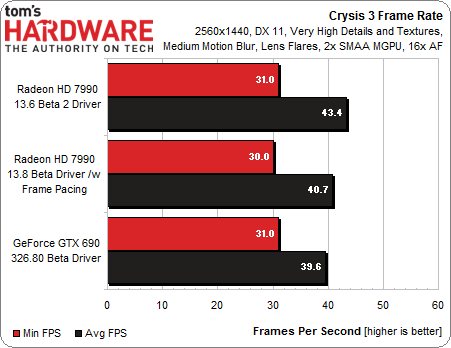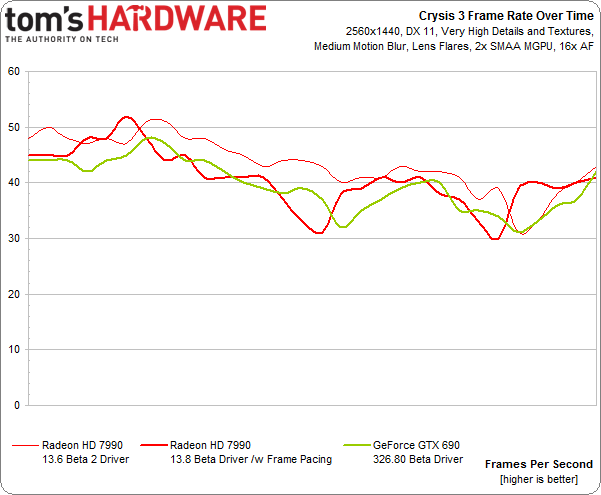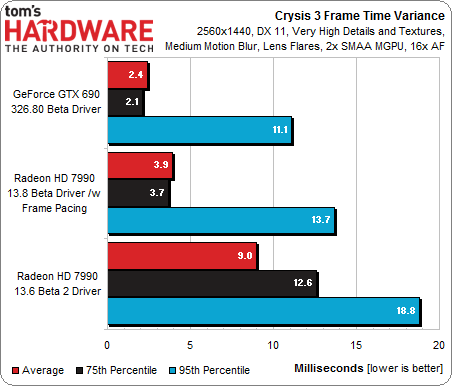Dual-GPU Battle: Does Frame Pacing In Catalyst 13.8 Turn The Tide?
We take AMD's Catalyst 13.8 beta driver for a spin to see if its frame pacing feature fixes CrossFire's dropped and runt frame issues. Follow along as we compare the Radeon HD 7990 to Nvidia's GeForce GTX 690 in seven popular titles, with video to match!
Results: Crysis 3
We begin with Crysis 3, a title that's well known for its high-quality graphics and substantial performance requirements.
According to our measure of average and minimum frame rates, frame pacing does little. But the feature really isn't intended to affect the averages much. What we want to see is consistent performance levels, and a smoother gaming experience.
Charting frame rate over time shows that the 13.6 driver tends to have an edge over 13.8, perhaps a result of frame pacing adding small delays in an attempt to smooth out the cadence at which the Radeon HD 7990 puts frames on-screen. This accounts for the small drop in average frame rate.
Now, when we look at frame time variance, which tells us the difference between the time it takes to display a frame compared to the average time it takes to display the frames before and after it. This is the data we're most interested in, given the purpose of frame pacing.
And indeed, we see a significant impact. I don't want to give away too much, but there's going to be a part two of this story going live tomorrow where volunteer gamers weigh in on their experiences with Radeon HD 7990 and GeForce GTX 690. Although there are variables that make my objective exploration different from that piece, you're going to see definitive correlation between the reduction of frame time variance observed here and the opinions of gamers who play Crysis 3 on both graphics cards, not knowing which one is which.
Until then, here's a video to show what I saw in each of the three scenarios above:
The differences are subtle, and because this is a manual walk-through (by necessity), there may be differences of opinion in the audience. But from my point of view, Catalyst 13.8 does appear smoother than Catalyst 13.6 in Crysis 3. The GeForce GTX 690 appears roughly as smooth as the Radeon HD 7990 with frame pacing enabled.
Get Tom's Hardware's best news and in-depth reviews, straight to your inbox.
Don Woligroski was a former senior hardware editor for Tom's Hardware. He has covered a wide range of PC hardware topics, including CPUs, GPUs, system building, and emerging technologies.
-
jimmysmitty The drivers do seem to make the FPS much smoother overall. BF3 is a good example with the game dropping then jumping and so on but 13.8 made it a much smoother line.Reply
Its good to see that work is being done to make it more competitive but I fear that its almost pointless since Hawaii XT is on its way and will be a better option in CFX.
Also Laras hair on the GTX690 was funny. Just fluttering around like crazy. I guess TressFX does make a difference after all. -
jase240 This is great, AMD is finally getting on par for dual GPU config with Nvidia!!Reply
This might make 2 AMD cards a way better value than Nvidia!! -
viewgamer The Metro Last Light benchmark is a modern example of the way Nvidia handles its business.Reply
These strong arm tactics to eliminate the competition aren't beneficial to anyone, Nvidia's less than pleasant business practices is why I try to support AMD whenever possible. -
viewgamer The Metro Last Light benchmark is a modern example of the way Nvidia handles its business.Reply
These strong arm tactics to eliminate the competition aren't beneficial to anyone, Nvidia's less than pleasant business practices is why I try to support AMD whenever possible. -
Emma Long Apart from Metro the 7990 tied the 690 on two occasions and beat it in the rest, that's very encouraging from the red team.Reply
The situation with Metro last light seems peculiar to me, we've seen things like this before with Nvidia sponsored titles & I thought the industry was passed this sort of thing.
Nvidia can compete, it has proven so time and time again, which makes this all the more reprehensible.
I would like to see an Nvidia that competes on the basis of performance & features not strong-arming developers.
Back to the 7990, so overall it's faster than the 690 and significantly less expensive, at $700 the 7990 puts very serious pressure on the 780 so I'd like to see the 780 added into the benchmarking mix as well. -
CarlitoBanderas What's the point of a 690 ? in 1080o & 1440p it's slower than the 7990, in 4K & multi monitor it doesn't have enough memory & it's 300 bucks more expensive.Reply
Nvidia needs to bring out a 790 asap, the 690 is not competitive anymore. -
m32 I've enjoyed this article, Toms. We've seen the flaws and now some improvements with the 7990.Reply -
aggroboy Reply
Enthusiast mindshare is still dominated by the GTX Titan, so Nvidia can afford to stand pat.11476339 said:What's the point of a 690 ? in 1080o & 1440p it's slower than the 7990, in 4K & multi monitor it doesn't have enough memory & it's 300 bucks more expensive.
Nvidia needs to bring out a 790 asap, the 690 is not competitive anymore.



